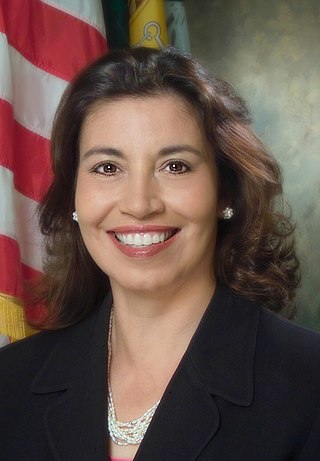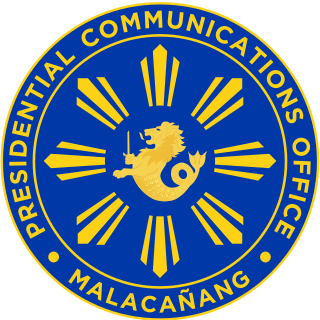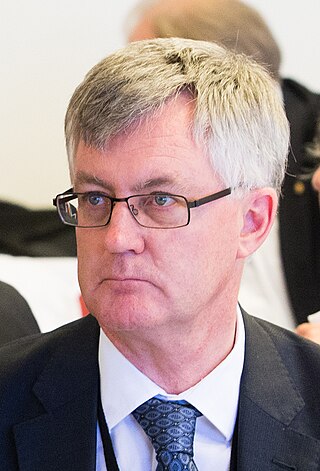Related Research Articles

The chief of naval operations (CNO) is the professional head of the United States Navy. The position is a statutory office held by an admiral who is a military adviser and deputy to the secretary of the Navy. In a separate capacity as a member of the Joint Chiefs of Staff, the CNO is a military adviser to the National Security Council, the Homeland Security Council, the secretary of defense, and the president. The current chief of naval operations is Admiral Michael M. Gilday.

The United States Secretary of the Treasury is the head of the United States Department of the Treasury, and is the chief financial officer of the federal government of the United States. The Secretary of the Treasury serves as the principal advisor to the president of the United States on all matters pertaining to economic and fiscal policy. The Secretary is, by custom, a member of the Cabinet of the United States and, by law, a member of the National Security Council.

The United States secretary of defense (SecDef) is the head of the United States Department of Defense, the executive department of the U.S. Armed Forces, and is a high ranking member of the federal cabinet. The secretary of defense's position of command and authority over the military is second only to that of the president of the United States, who is the commander-in-chief. This position corresponds to what is generally known as a defense minister in many other countries. The secretary of defense is appointed by the president with the advice and consent of the Senate, and is by custom a member of the Cabinet and by law a member of the National Security Council.

The Department of the Treasury (USDT) is the national treasury and finance department of the federal government of the United States, where it serves as an executive department. The department oversees the Bureau of Engraving and Printing and the U.S. Mint. These two agencies are responsible for printing all paper currency and coins, while the treasury executes its circulation in the domestic fiscal system. The USDT collects all federal taxes through the Internal Revenue Service; manages U.S. government debt instruments; licenses and supervises banks and thrift institutions; and advises the legislative and executive branches on matters of fiscal policy. The department is administered by the secretary of the treasury, who is a member of the Cabinet. The treasurer of the United States has limited statutory duties, but advises the Secretary on various matters such as coinage and currency production. Signatures of both officials appear on all Federal Reserve notes.
The United States order of precedence is an advisory document maintained by the Ceremonials Division of the Office of the Chief of Protocol of the United States which lists the ceremonial order, or relative preeminence, for domestic and foreign government officials at diplomatic, ceremonial, and social events within the United States and abroad. The list is used to mitigate miscommunication and embarrassment in diplomacy, and offer a distinct and concrete spectrum of preeminence for ceremonies. Often the document is used to advise diplomatic and ceremonial event planners on seating charts and order of introduction. Former presidents, vice presidents, first ladies, second ladies, and secretaries of state and retired Supreme Court justices are also included in the list.

The secretary of the Air Force, sometimes referred to as the secretary of the Department of the Air Force, is the head of the Department of the Air Force and the service secretary for the United States Air Force and United States Space Force. The secretary of the Air Force is a civilian appointed by the president, by and with the advice and consent of the Senate. The secretary reports to the secretary of defense and/or the deputy secretary of defense, and is by statute responsible for and has the authority to conduct all the affairs of the Department of the Air Force.

Anna Escobedo Cabral is an American politician who serves as the Unit Chief for Strategic Communications in the External Relations Division of the Inter-American Development Bank (IDB). Prior to joining the bank, Cabral served as the 42nd Treasurer of the United States from January 19, 2005, to January 20, 2009. She became the highest-ranking Latina in the George W. Bush administration after the resignation of Rosario Marin.

The Commissioner of Internal Revenue is the head of the Internal Revenue Service (IRS), an agency within the United States Department of the Treasury.

Robert Michael Kimmitt was United States Deputy Secretary of the Treasury under President George W. Bush. He was nominated by President Bush on June 29, 2005. The United States Senate unanimously confirmed him on July 29, 2005, and he was sworn into office on August 16, 2005. Kimmitt served through the end of the Bush administration, leaving office on January 20, 2009.

The United States Deputy Secretary of the Treasury, in the United States government, advises and assists the Secretary of the Treasury in the supervision and direction of the Department of the Treasury and its activities, and succeeds the Secretary in the secretary's absence, sickness, or unavailability. The Deputy Secretary plays a primary role in the formulation and execution of Treasury policies and programs in all aspects of the Department's activities. In addition, the Deputy Secretary is the only official other than the secretary who can sign a Treasury order, which is a document that delegates authority residing in the secretary or Deputy Secretary to another Treasury official, establishes Treasury policy, and establishes the reporting relationships and supervision of officials. Former deputy secretaries include Roger Altman, Lawrence Summers, Stuart E. Eizenstat, Kenneth W. Dam, and Samuel Bodman.

Jacob Joseph Lew is an American attorney and politician who served as the 76th United States Secretary of the Treasury from 2013 to 2017. A member of the Democratic Party, he also served as the 25th White House Chief of Staff from 2012 to 2013 and Director of the Office of Management and Budget in both the Clinton administration and Obama administration.

The State Treasurer of Oklahoma is the chief custodian of Oklahoma’s cash deposits, monies from bond sales, and other securities and collateral and directs the investments of those assets. The treasurer provides for the safe and efficient operation of state government through effective banking, investment, and cash management. The state treasurer has the powers of a typical chief financial officer for a corporation.

The Presidential Communications Group, or simply the Communications Group, is the collective name for the offices within the Office of the President of the Philippines and refers to the position of the Secretary of Presidential Communications Office formerly known as Office of the Press Secretary and the Secretary of the Presidential Communications Operations Office (PCOO). The office of the presidential spokesperson was previously under the Communications Group.

Sergey Yevgenyevich Naryshkin is a Russian politician and businessman who has served as the director of the Foreign Intelligence Service since 2016. Previously, he was Chairman of the State Duma (2011–2016) and Kremlin Chief of Staff (2008–2012); he was also chairman of the Historical Truth Commission in May 2009 until it was dissolved in February 2012.
The Order of Precedence in Sri Lanka the protocol list at which Sri Lankan government officials are seated according to their rank. This is not the list of succession.
The Presidential Task Force on the Auto Industry was an ad hoc group of United States cabinet-level and other officials that was formed by President Obama to deal with the financial bailout of automakers Chrysler and General Motors.
The chief investment officer (CIO) is a job title for the board level head of investments within an organization. The CIO's purpose is to understand, manage, and monitor their organization's portfolio of assets, devise strategies for growth, act as the liaison with investors, and recognize and avoid serious risks, including those never before encountered.

Martin Lee Parkinson is a senior Australian public servant. He was Secretary of the Department of the Treasury between March 2011 and December 2014. On 3 December 2015 it was announced that he would return to the public service as Secretary of the Department of Prime Minister and Cabinet. He retired from the position on 30 August 2019 and was replaced by Phil Gaetjens, former chief of staff to Prime Minister Scott Morrison. Parkinson has served as the Chancellor of Macquarie University since 2019.

Accounts Chamber of the Russian Federation is the parliamentary body of financial control in the Russian Federation.
References
- ↑ "Treasury Order 101-05". February 19, 2008. Archived from the original on 2009-05-06. Retrieved 2009-05-25. A January 1999 edition of the order over secretary Robert E. Rubin's signature (and also detailing a chief of staff position) is the earliest-archived one at web.archive.org a/o March 19, 2023.